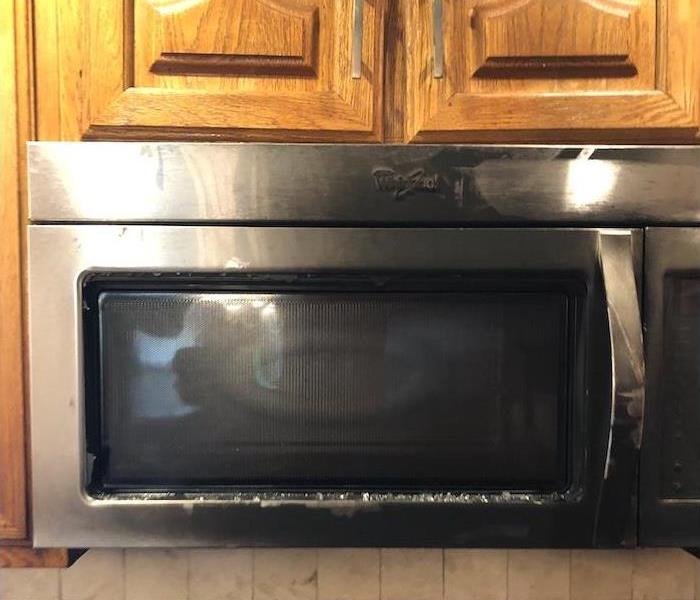What Methods Are Used to Clean Soot, Ash, and Smoke in a Property?
10/29/2020 (Permalink)
Combusting Materials Produce Significant Soiling of a Property
Why do smoke residues stick to surfaces?
At high temperatures, smoke residues and soots can bond to surfaces in your Fort Lee home. Once there is a reduction in temperature, some of these soils remain chemically bonded to the surface. A vital part of a fire restoration technician training is how to break the connection between soil and a surface without causing further harm to the structure or contents. The methods we use to break this bond can be chemical, agitative, or aggressive. Each method has different characteristics, and trained technicians must choose the correct one for each part of your home. Breaking the bonds between soots and surfaces often means the items can return to a good-condition following a fire without resorting to the increasing cost of replacing them.
What makes up smoke residues?
When performing fire cleanup in your Fort Lee home, it is essential to determine the type of smoke residue before cleaning. When materials combust, they alter chemically as solid turns to gas. These materials chemically change depending on the type of material, either synthetic or natural, and the temperature of the fire. When coming into contact with surfaces, the heat and pressure can result in further chemical reactions. When dealing with fire soots or smoke residues, it is essential to act cautiously to avoid inadvertently causing extra harm. Light-vacuuming or dry brushing surfaces is a safe way to remove smoke residues. However, not all residues respond well to water, chemical cleaning agents, or temperature. Some residues may spread around when water and scrubbing are introduced. This is a situation that can be avoided by using professional restoration technicians.
How do different methods work to reduce fire soiling in a property?
- Chemical cleaning methods generally dissolve, chemically alter or suspend the soils within the cleaning agent to be rinsed away.
- Agitation cleaning repeatedly scrubs a part of the soil using brushes, roto machines, or steel wool to loosen the bond enough for the surface to be washed.
- Aggressive cleaning methods focus on removing surface layers through blasting sodium, sand, or glass particles against the surface. This method often requires refinishing the surface.
How do cleaning products alter soots or soils?
When materials combust, they release numerous particles into the atmosphere. The temperature and pressure causes it to seek out cold surfaces. This phenomenon is why fires appear to billow out smoke, and interior drawers or cabinets often show significant soiling signs. Chemically altering soil can help to release the bond between smoke residue and material. Detergent is a household product that chemically transforms soils by emulsifying compounds into a foam and then cleaning away with water. SERVPRO technicians may attempt to address the pH balance when performing chemical altering of material.
How does pH balance affect restoration?
- Using pH litmus paper, soil testing is used to determine the acidity or alkalinity of a surface.
- Alkaline soots and soils dissolve best in equal-weighted cleaning solutions
- Mixing and applying the necessary products with sufficient 'dwell time' which allows for chemical alteration to take place
How does agitated cleaning reduce soot and smoke damages?
Agitative cleaning is commonly used by all homeowners, whether washing dishes or scrubbing surfaces. The cleaning principle is much the same in the restoration industry, albeit with more robust equipment and tools. Friction produces heat, and the two together can help to dislodge soots from surfaces. One piece of equipment we use to accentuate this process is a rotary machine. A rotary engine can be fitted with steel wool or robust material and is then spun at hundreds of revolutions per minute. These can be applied directly to surfaces and do not involve water, helping dry smoke damages. Often a rotary machine is run over a body several times to remove all soots and double up as a machine for polishing or buffing surfaces.
How do immersion cleaning methods remove soots from items?
- The item is fully-submerged with an appropriate cleaning solvent or solution. Items must be strong enough to withstand full immersion in the solvent for this type of cleaning.
- Ultrasonic soundwaves create millions of bubbles within the immersion tank.
- As bubbles burst against the item, they produce heat and friction, which can help restore valuable metals or items like drapery rods.
Knowing and applying the right methods of cleaning agents to apply to fire damages can reduce secondary harm and return your property to its preloss condition. Contact SERVPRO of Fort Lee at (201) 496-6024 now.






 24/7 Emergency Service
24/7 Emergency Service
